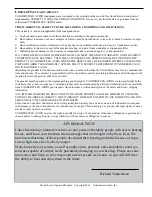
V
ANDERSTEEN
A
UDIO
10
A
COUSTICAL
C
ENTER
The Model Seven’s acoustical center is at the top front
center of the grille frame. In a perfectly rectangular room
with absolutely rigid walls and no doors or windows, the
acoustical center of the loudspeaker would be placed ex-
actly at the point where the two dimensions intersect to
realize the full benefits of odd dimensions placement. In a
real room, the actual best placement may vary from the
intersection by several inches. Fine-tuning the placement
by moving the speakers a few inches off the calculated
intersections takes these real world conditions into ac-
count.
You should not use any placements that put the acous-
tical center of the loudspeaker the same approximate dis-
tance from the rear and side walls or where one distance is
a multiple of the other. In our example room, this would
eliminate the intersection of the 24 inch width and length
lines since they are both the same distances from their
respective walls. It would also eliminate the intersection
of the 24 inch width line and 72 inch length line because
72 is a multiple of 24. (3 x 24 = 72) If any of the odd di-
mension intersections in your room are within a few
inches of being the same distance from the side and rear
walls or multiples of each other, you should not use them.
S
PEAKER
T
OE-
I
N
The degree of toe-in can effect the imaging and re-
sponse characteristics of the speakers. In most rooms, the
speakers will work well with twenty degrees of toe-in.
Speakers that are placed close to the side walls or in
rooms with very reflective side walls may require addi-
tional toe-in to avoid a confused image and/or a forward
midrange and treble. Although rare, in some rooms the
speakers may actually perform better with a slight amount
of toe-out.
A
COUSTIC
T
REATMENTS
If the speakers are close to the side walls and you hear
a brightness in the midrange/treble or a problem with the
imaging that toeing-in the speakers does not help, some
sound diffusers should be mounted on the side walls to
control reflections.
To determine where the sound diffusers should be
placed, imagine that the walls are mirrors and mount
them on the walls where you would see the reflections
of the speakers when you are sitting in your normal
listening position. Before you actually mount anything
on the side walls, experiment with the diffusers loca-
tion to verify that you will get the results you desire.
Speaker
Speaker
Listening
Position
If your listening position is close to the wall behind
you, mount some sound absorbent material, such as a
hanging tapestry, directly behind your head. As with
the diffusers for the side walls, experiment with a pil-
low or a folded natural-fiber blanket to verify the re-
sults before you acquire or mount the material.
H
ELPFU
L
H
INTS
A. To try the speakers on different walls, set your
equipment in the middle of the room so the
speaker cables can reach each possible location.
B. When you change the placement of the speakers,
listen to several different reference quality music
recordings before judging the results of the
change.
C. If you set the speakers on a wood floor, use spike
shoes to protect the floor from damage.
D. Don’t over-analyze the sound of each placement.
When the sound is right, it will be obvious.
E. Keep notes on the sound of different placements
you try. It is easy to get mixed-up and forget
which placement sounded the best.
The Model Sevens break-in and significantly improve during the first 100 hours of
use. Until this period has elapsed, the speakers exhibit some sonic aberrations as the
parameters of the Model Seven were established with completely broken-in drivers.




















